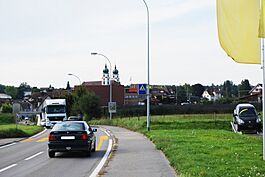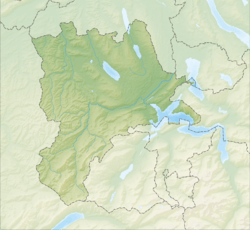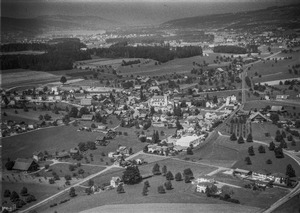Eschenbach, Lucerne facts for kids
Quick facts for kids
Eschenbach
|
||
|---|---|---|
 |
||
|
||
| Country | Switzerland | |
| Canton | Lucerne | |
| District | Hochdorf | |
| Area | ||
| • Total | 13.21 km2 (5.10 sq mi) | |
| Elevation | 473 m (1,552 ft) | |
| Population
(Dec 2020 )
|
||
| • Total | 3,677 | |
| • Density | 278.35/km2 (720.9/sq mi) | |
| Postal code |
6274
|
|
| Surrounded by | Ballwil, Buchrain, Emmen, Hochdorf, Inwil, Rain, Rothenburg | |
Eschenbach is a town in Switzerland. It is located in the canton of Lucerne. Eschenbach is part of the Hochdorf district.
Contents
History of Eschenbach
Eschenbach is a very old place. It was first mentioned in official papers way back in the year 924. Back then, it was called Eskinpah or Essinpahc.
Eschenbach's Coat of Arms
Every town has a special symbol called a coat of arms. It's like a unique badge for the town. Eschenbach's coat of arms shows a black castle. Above the castle, there is a cross made of four special hooks. The background color is gold.
Geography of Eschenbach
Eschenbach is located on flat land. This land was shaped by glaciers long ago. It sits between the Reuss River and the Seetal valley.
The town covers an area of about 13.2 square kilometers (about 5.1 square miles). A large part of this land, about 74%, is used for farming. Forests cover about 14.5% of the area. The rest of the land is used for buildings and roads (10.5%). A very small part (0.8%) is made up of rivers or other non-farmable land.
People of Eschenbach (Demographics)
Eschenbach has a population of 3,677 people (as of 31 December 2020). Over the last 10 years, the number of people living here has grown by almost 20%.
Most people in Eschenbach speak German (about 95%). A smaller number of people speak Albanian (1.5%) or Italian (0.8%).
Education and Homes
People in Switzerland are generally well-educated. In Eschenbach, about 77% of adults (aged 25-64) have finished high school or gone on to higher education. This means they might have gone to a university or a special college.
In the year 2000, there were 1,070 homes in Eschenbach. About a quarter of these homes (25.6%) had only one person living in them. About 12% were large homes with five or more people. Most homes in Eschenbach are two or three stories tall.
Jobs and Work
Eschenbach has a low unemployment rate, which means most people who want to work can find a job.
Jobs in Eschenbach are divided into three main types:
- Primary sector: This includes jobs like farming. About 183 people work in this area.
- Secondary sector: These are jobs in factories or construction. About 408 people work here.
- Tertiary sector: This includes jobs in services, like shops, offices, or schools. About 581 people work in this sector.
In 2000, more than half of the people in Eschenbach had a job (54.5%). Women made up about 43% of the workers.
Religion
In 2000, most people in Eschenbach were Roman Catholic (about 80.5%). About 8.6% were Protestant. There were also people of other Christian faiths and about 2.7% of the population was Muslim. Some people did not belong to any organized religion.
Population Changes Over Time
The table below shows how Eschenbach's population has changed through history:
| Year | Population |
|---|---|
| About 1695 | around 400 |
| 1798 | 1,097 |
| 1816 | 790 |
| 1850 | 1,229 |
| 1900 | 1,204 |
| 1950 | 1,656 |
| 2000 | 2,966 |
See also
 In Spanish: Eschenbach (Lucerna) para niños
In Spanish: Eschenbach (Lucerna) para niños





